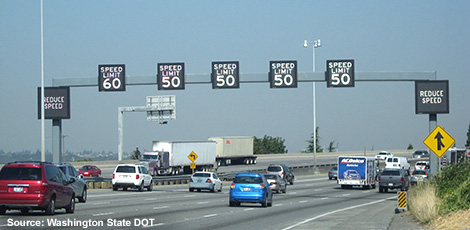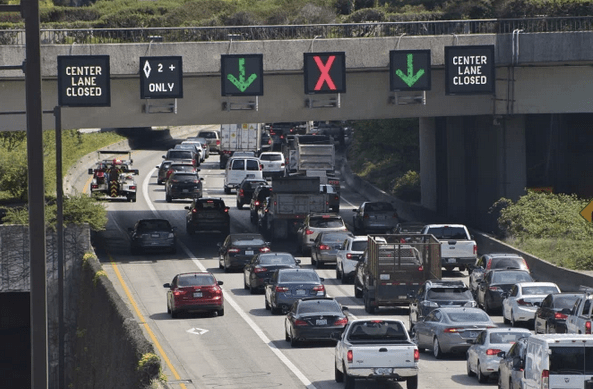TechCrunch is hosting a mobility-focused, virtual conference on June 9. The event will feature everything from micrombility and smart cities to autonomous vehicles and electric aircrafts. Join 2K+ mobility industry leaders, startups, and investors and save an extra 10% on tickets with promo code “streets.” Book tickets now: https://tcrn.ch/2QnyCjv
Advocates are fighting for better protection for vulnerable road users from the federal manual that dictates how signs, signals and roadway markings work on U.S. roads. But some are going further to urge the Department of Transportation to set strong standards for the virtual signals that have just as much of an impact on how drivers behave in our communities — and give cities more tools to rein in the private companies that are making life hell for non-drivers.
Late last week, a loose coalition of advocates asked the Federal Highway Administration to address the rise of “digital signaling” in the next edition of the Manual of Uniform Traffic Control Devices (aka the MUTCD), which is being revised for the first time in 12 years. The MUTCD has been the focus of intense scrutiny among safe streets advocates, who argue the manual doesn’t do enough to mandate that cities implement safe speed limits, walker-friendly signal timing at intersections, and other roadway features that protect vulnerable road users.
But while the minds behind the Manual have clung to dangerously outdated standards like the 85th percentile rule (not to mention a a general aversion to effective crosswalks and bike lanes), new technology has rapidly reshaped U.S. streets. The proliferation of electric scooters, bike-share and delivery apps has unleashed whole fleets of new mobility options onto communities, clotting curbs and sidewalks in ways that inventor of the simple “No parking” sign probably never dreamed of. App-based taxi giants like Uber and Lyft, meanwhile, have begun vying for the same scarce curb space, congesting entire megacities as leaders look
And if autonomous vehicles develop as quickly as some experts predict, the analog traffic control devices outlined in the MUTCD may be even more inadequate to actually control traffic — at least if leaders want to do more than just tell a Tesla to stop at a stoplight.
But advocates argue that in the hands of a thoughtful transportation leader, the data generated by the universe of smart city apps can be used to develop digital traffic control devices – like smart parking meters that automatically issue drivers a ticket if they idle in a bike lane, dynamic speed limit signs that ratchet down the speed of drivers when walkers are present — and even invisible street signs, like “geofences” that tell autonomous cars not to enter a pedestrian plaza.
And they also argue that, by not acknowledging the impact of smart mobility on our streets right now, the MUTCD is essentially letting private companies control much of our traffic by default — and not always in ways that are good for our communities.
“In the last 10 to 15 years, all of these new mobility modes have started operating in a virtual world, on top of the public right of way,” said Hugh Martin, CEO of Lacuna Technologies, a company which helps cities manage the onslaught of new mobility tech in their communities and use the data they generate for public benefit. “It’s been the wild west. There is no accountability or regulation in the digital domain, and all of these operators — ride hail companies, curb management companies, micromobility, you name it — basically have free rein to do whatever they want. These are all operators that want to deliver a profit to shareholders; they don’t have the health and safety of communities as their primary objective.”
How cities can get Big Tech out of the driver's seat
Cities across America have tried to treat the worst side effects of the smart mobility revolution, but it hasn’t been easy.
When the City of Los Angeles required Uber to provide the government with basic, anonymized data about where its Jump scooters ended up (to ensure equitable distribution in low-income neighborhoods), Uber sued, alleging that the government was invading residents’ privacy. The ACLU continued the fight after Uber sold Jump to Lime, but its suit was dismissed in February. Today, 32 US cities and regions use the same digital dashboard developed by Los Angeles, called the Mobility Data Specification tool, to view the data generated by private mobility providers and craft policy based on what they see.
But even with that powerful tool in hand, cities still don’t have a ton of real-time information about what, exactly, mobility tech companies are doing on our road network — and that means they don’t have the tools they need to dynamically regulate it.
“For instance, here in Los Angeles, when I-5 gets jammed up, navigation apps will often a route a whole bunch of vehicles onto this tiny residential side street because an algorithm says that’s what will move traffic most efficiently,” said Martin. “The city, of course, cares deeply about the policy and the safety issues around that side street, and [using the tools in the current MUTCD], they can do some things to control traffic, like lower the speed limit on that road, or put up some speed bumps and post a 'speed bump' sign next to it. But if we had a digital equivalent of the MUTCD, there might be a policy that said, ‘OK, for a residential street of this width with parking on both sides, we’re going to allow 50 cars per day to be routed down this street, that’s it — and when the [mobility dashboard] says we’ve reached that threshold, the navigation system legally has to put those cars on another route.'”
Adding a few smart mobility chapters to MUTCD wouldn’t just stop Google Maps from sending a parade of freight trucks down a suburban boulevard just to save drivers a few minutes on the road. It could also give cities the tools they need to create dynamic signage that, say, charges drivers congestion tolls that surge in price during rush hour, or stops taxi drivers from accepting new fares in a neighborhood when app taxi companies have collectively exceeded their daily budget for greenhouse gas emissions. Traffic signals could be programmed to give walkers more time to cross when pedestrians surge out of an arena after a baseball game, or to give an approaching cyclist a special green light before drivers are allowed to proceed — and countless other possibilities that engineers haven’t dreamed up yet.
A standard, aluminum-and-paint road sign can give drivers more sophisticated information about how to behave around vulnerable road users. But some advocates argue that a “Speed Limit 25 When School in Session” or “No Parking 4-6 p.m.” sign just won’t cut it in our new, tech-savvy world — especially when technology can do so much more.

“Currently, we have a short message pasted on a small traffic sign and relying on road users to understand everything that might mean about how they can interact in a public right of way,” said Carlos Cruz, assistant director of Miami-Dade County’s Department of Transportation and Public Works. “But [the reality on] our streets changes every hour. … It’s critical that we find ways to [manage demand for our roadspace] without covering our city in street signs — because we already have two million signs in Miami.”
Traffic control beyond signs and paint
Cruz is among the public officials who are urging U.S. DOT Secretary Pete Buttigieg to start thinking of smart mobility as driving the next evolution of the analog traffic control device — even when a roadway rule is communicated through an invisible signal, rather than posted on a pole that’s anchored in the ground.
And with semi-autonomous vehicles already on the road — for better or worse — those unseen signs may soon be more important than ever. Martin cites a 2018 incident when the California Highway Patrol stopped an intoxicated driver who decided to rely on his Tesla “autopilot” feature to get him home safely, fell unconscious, and was unavailable to stop his vehicle when law enforcement officers attempted to pull him over.
“The only way the police could slow him down was to physically put their cruisers in front of the car and trick the AV into thinking it was stuck in a traffic jam,” Martin said. “Now what if there were 10,000 AVs on our roads, and in every one of them, people were drunk, or playing video games, or sleeping? What happens when the car malfunctions? How can we make sure that laws are being obeyed by communicating directly between traffic devices and cars — especially when, functionally, there isn’t a human being behind the wheel?”
That techno-dystopian possibility might not sound appealing to those who worry that even autonomous cars will still perpetuate the worst aspects of car culture — especially if U.S. cities continue to be built to support privately owned vehicles, whether autonomous or not, instead of cars that are shared among many drivers.
But as the universe of smart mobility technology continues to grow, advocates like Cruz and Martin hope that at least some of their applications can be harnessed for the benefit of vulnerable road users — especially if the MUTCD gives cities more tools to use that data to get the transportation outcomes they want.
“Cities need not to lock up the barn after all the horses have left; it’s super important for cities to get out in front and co-developing this with commercial companies,” said Martin. “The MUTCD doesn’t get updated very often; we shouldn’t wait another 12 years to do this.”






